The GIGABYTE B360 Gaming 3 WIFI Review: A Cheaper Alternative at $120
by Joe Shields on July 11, 2018 9:45 AM ESTCPU Performance, Short Form
For our motherboard reviews, we use our short form testing method. These tests usually focus on if a motherboard is using MultiCore Turbo (the feature used to have maximum turbo on at all times, giving a frequency advantage), or if there are slight gains to be had from tweaking the firmware. We leave the BIOS settings at default and memory at JEDEC for the supported frequency of the processor for these tests, making it very easy to see which motherboards have MCT enabled by default.
Rendering - Blender 2.78: link
For a render that has been around for what seems like ages, Blender is still a highly popular tool. We managed to wrap up a standard workload into the February 5 nightly build of Blender and measure the time it takes to render the first frame of the scene. Being one of the bigger open source tools out there, it means both AMD and Intel work actively to help improve the codebase, for better or for worse on their own/each other's microarchitecture.
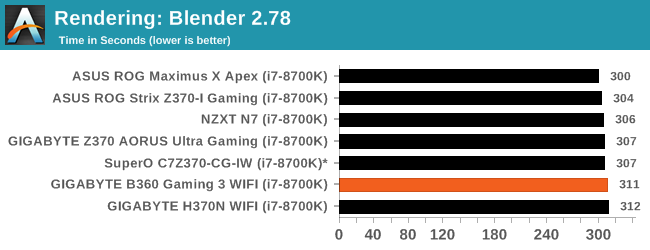
The H370N WIFI completed the Blender benchmark in 312 seconds. This result is a bit slower than the main grouping by a couple seconds. The range of results spans a range of around 4% from the fastest to slowest with the majority of results hovering around the 306s median.
Rendering – POV-Ray 3.7: link
The Persistence of Vision Ray Tracer, or POV-Ray, is a freeware package for as the name suggests, ray tracing. It is a pure renderer, rather than modeling software, but the latest beta version contains a handy benchmark for stressing all processing threads on a platform. We have been using this test in motherboard reviews to test memory stability at various CPU speeds to good effect – if it passes the test, the IMC in the CPU is stable for a given CPU speed. As a CPU test, it runs for approximately 1-2 minutes on high-end platforms.
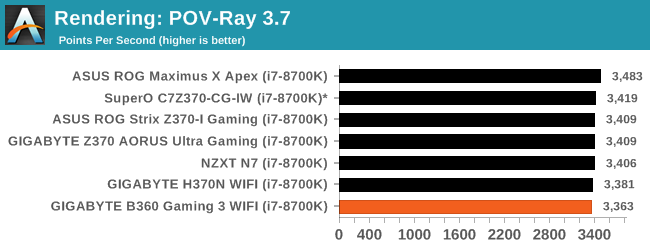
POV-Ray results show the Mini-ITX board hanging with the pack in this thread heavy benchmark. All boards ran the benchmark at the same clock speed of 4.3 GHz. This particular group of results is very tight with around a 1% difference (margin of error) separating the meat of the results.
Compression – WinRAR 5.4: link
Our WinRAR test from 2013 is updated to the latest version of WinRAR at the start of 2014. We compress a set of 2867 files across 320 folders totaling 1.52 GB in size – 95% of these files are small typical website files, and the rest (90% of the size) are small 30-second 720p videos.
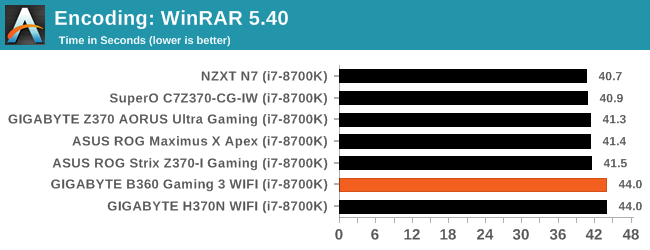
The WinRAR results show our little board completing this test in 44 seconds. This result is slowest we have seen, by almost 10%. All clocks and speeds were the same and we did not see any throttling listed through a sanity check.
Synthetic – 7-Zip 9.2: link
As an open source compression tool, 7-Zip is a popular tool for making sets of files easier to handle and transfer. The software offers up its own benchmark, to which we report the result.
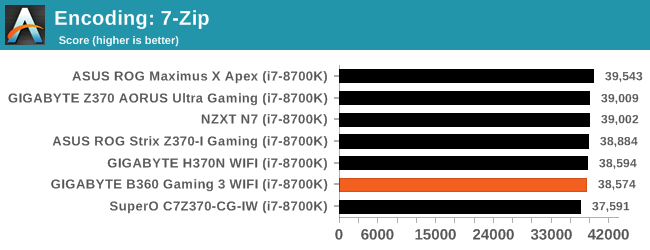
For encoding in 7-Zip, the B360 Gaming 3 WIFI scored 38574 mixing right in with the rest of the results.
Point Calculations – 3D Movement Algorithm Test: link
3DPM is a self-penned benchmark, taking basic 3D movement algorithms used in Brownian Motion simulations and testing them for speed. High floating point performance, MHz, and IPC win in the single thread version, whereas the multithread version has to handle the threads and loves more cores. For a brief explanation of the platform agnostic coding behind this benchmark, see my forum post here.
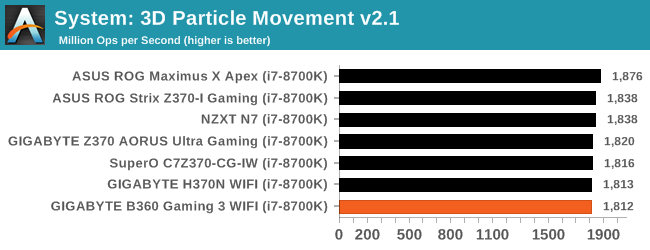
In 3DPM2.1, The B360 reached 1812 Mop/s. This result, the lowest so far, is within the margin of error for results as it is around 1% behind the 2nd place result. The CPUs all ran the same speeds in this test, so again we see a margin of error size differences between our datasets so far.
Neuron Simulation - DigiCortex v1.20: link
The newest benchmark in our suite is DigiCortex, a simulation of biologically plausible neural network circuits, and simulates activity of neurons and synapses. DigiCortex relies heavily on a mix of DRAM speed and computational throughput, indicating that systems which apply memory profiles properly should benefit and those that play fast and loose with overclocking settings might get some extra speed up. Results are taken during the steady state period in a 32k neuron simulation and represented as a function of the ability to simulate in real time (1.000x equals real-time).
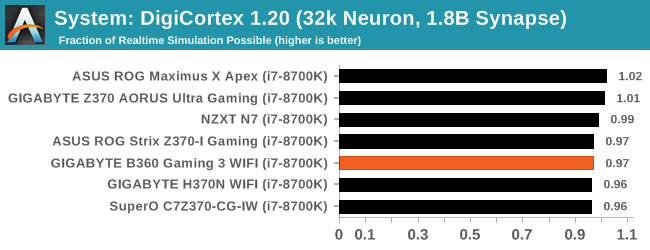
Our DigiCortex results show the B360 offering mixing in seamlessly with the rest of the results. Nothing anomalous here.










18 Comments
View All Comments
drw28 - Wednesday, July 11, 2018 - link
can you review the gigabyte UD pro drives?the combination of phison s10 and toshiba's bics nand would be interesting to see.peevee - Wednesday, July 11, 2018 - link
There used to be you could get a decent ATX MB for the latest mainstream CPU for around $50. What happened? Is it Intel overpricing their chipsets?imaheadcase - Wednesday, July 11, 2018 - link
In what world did you visit to get that cheap..i think you are mistaken.DanNeely - Wednesday, July 11, 2018 - link
In aggressive sales perhaps. Otherwise, while I recall seeing an occasional $50 board; the reviews always indicated that there was something wrong with them. Either from a company known to only build garbage (eg PC Chips, ECS before they figured out how to make good products, or a few other companies who're dead and forgotten) or an occasional screwed up board from a mainstream brand. I remember getting an ASUS S939 board for maybe $60 years ago, when it crapped out and I looked at reviews I turned out that I wasn't alone, something like 50% 1/2 stars from people whose boards had died on them.The True Morbus - Thursday, July 12, 2018 - link
I think there used to a PERCEPTION that you could get a decent board for 50 bucks, but that's probably because most 150$ boards looked similar to most 50$ boards.You can still buy the 50$ boards if you want. They'll be the first thing to give out in the build, you can write that down. And no, it doesn't matter if they're from a famous brand, they'll likely give out even quicker if that's the case.
PeachNCream - Thursday, July 12, 2018 - link
The last $50 motherboard I purchased was a Gigabyte GA-F2A68HM-HD2 which was a FM2 socket mATX board. The SATA connectors all failed at the same time about three months after I bought it. There was a DVD drive on one and a 1TB WD hard drive on another when it gave up and stopped detecting devices. I tried a few other drives, shuffled ports around, got new cables, etc and the hard drive worked in an external case just fine (still is working in fact). It wasn't worth the trouble to go through customer support for RMA, but it was a bit annoying. That was the last time I wasted effort on a desktop of any sort and PC games for the most part as well. Glad to be done with that particular disaster after multiple decades of chasing system requirements. Cell phone gaming FTW!peevee - Thursday, July 12, 2018 - link
My last personal builds were in 2000 (on ASUS) and 2011 (ASRock). Never failed. Maybe they were 50-something.peevee - Thursday, July 12, 2018 - link
The latter is the Z68 board I still use. With then brand-new top-of-the-consumer-line i7-2600k.Still OCZ Vertex 3 256GB bought for $500 then, still works (although until they have fixed its firmware about a year later it had troubles). Now THAT one still alive is a surprise.
Galcobar - Wednesday, July 11, 2018 - link
Some copy editing might be in order. Aside from the raft of grammatical errors (e.g. worth vs worthy of), random commas and typos (e.g. B350, i7-8400), specifications are contradictory.For example, page 1: "... a total [of] four USB 2.0 ports, three USB 3.0 ports (one Type-C), and one USB 3.1 (10 Gbps) port (red Type-A)."
Page 2: "USB 2.0 (4x ports), USB 3.0 (3x ports) and a USB 3.1 Type-C port"
Also, when did Anandtech switch (back) to referring to USB 3.1 Gen 1 and Gen 2 as, respectively, USB 3.0 and 3.1? Five days ago it was the former.
Joe Shields - Wednesday, July 11, 2018 - link
The typo mentioned RE: USB was corrected. Thank you for catching that.As far as the 'switch'.... I know in my reviews, at least the past dozen or two, I have been referring to it in this manner consistently AFAIK. Prior to that I would use something like "USB 3.1 (speed here)" to clarify.